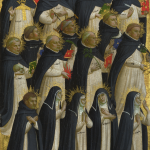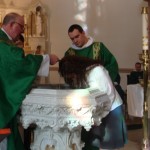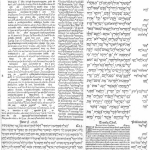This past Sunday, I attended an Orthodox liturgy for the first time, in the company of Miss Tristyn Bloom of Eschatological Psychosis. Tristyn gave me an overview Saturday night, so I’d know what to expect and be able to avoid augmenting my normal church awkwardness, but I still spent a fair amount of time of Google and Wikipedia to cover all my bases. While doing my research, I ran across one article earnestly explaining that the Orthodox don’t believe in Transubstantiation. (Note, before you run to the comments, I know this is not true).
The confusion seemed to be the result of the Orthodox approach to the Sacred Mysteries (which include those rituals that Catholics term Sacraments). Both Orthodox and Catholics profess a belief in the Real Presence — the idea that Christ is truly and fully present in the Eucharist, even though they retain the appearance of bread and wine. But, as the Orthodox terminology would suggest, the Catholics spend more time concerned about the how.
It’s hard not to have all my sympathies with the Catholics, since I enjoy picking apart the kind of metaphysical apologetics this approach yields, but further consideration has pushed me closer to the Orthodox view. These divine brain teasers may be fun to puzzle over, but inquiry along those lines isn’t at the heart of the Christian faith.
Consider the new, more technicalized Roman Missal (the script for Mass) set to go into effect this year. Here’s one of the changes that has sparked a backlash. In the Nicene Creed, the previous language of “Jesus… one in Being with the Father” will change to “Jesus… consubstantial with the Father.” One Catholic NYT commenter summed up the objection:
So, how do I explain “consubstantial” to my daughter, who is 9, attends Catholic school, along with her older brother, and pays attention and asks questions as she listens to the words of the homily every week at Mass? I have no problem with the idea of sticking closer to the Latin meaning, having studied the language in high school and college, but that doesn’t mean making it inaccessible
I understand her worry. At the getting-to-know-the-missal lesson hosted by the Catholic Church on campus, a fair proportion of the students couldn’t explain the meaning of the new language. But I’m not sure this is such a shift–the Nicene Creed is already a litany of highly technical metaphysical facts professed by the Church. The current version of the Creed reads in part:
We believe in one Lord, Jesus Christ,
the only Son of God,
eternally begotten of the Father, God
from God, Light from Light,
true God from true God,
begotten, not made,
one in Being with the Father.
Through him all things were made.
Reading through the list, I’m reminded of the tradition of fighter pilots keeping a painted tally of enemy aircraft down on the side of their own plane. This is a list of rebukes to defeated heresies that few people besides theologians are acquainted with. I couldn’t ever really make sense of the Creed until I read Diarmaid MacCulloch’s Christianity: The First 3000 Years and ran across them in his history.
So who are these fairly obscure fights relevant to? Well, theologians, certainly, in much the same way that arcane details are relevant to a Ph.D. candidate. It’s possible that discussing and researching these nuances is helpful to the spiritual formation of some Catholics, but it certainly isn’t a resource for the people who mouth the words of the Creed and have lost any sense of its meaning or historical urgency. Pushing everyone toward abstraction makes it hard to focus and act on the problems before us.
The Orthodox approach to mystery doesn’t cut off discussion, but it focuses it toward the questions Christians most urgently need to answer: how to take up your cross and follow Christ. Sacrements, liturgy, scripture, and tradition are all meant to help answer that question, not to be interrogated to the point of distraction.














